
Text © Giuseppe Mazza

English translation by Mario Beltramini
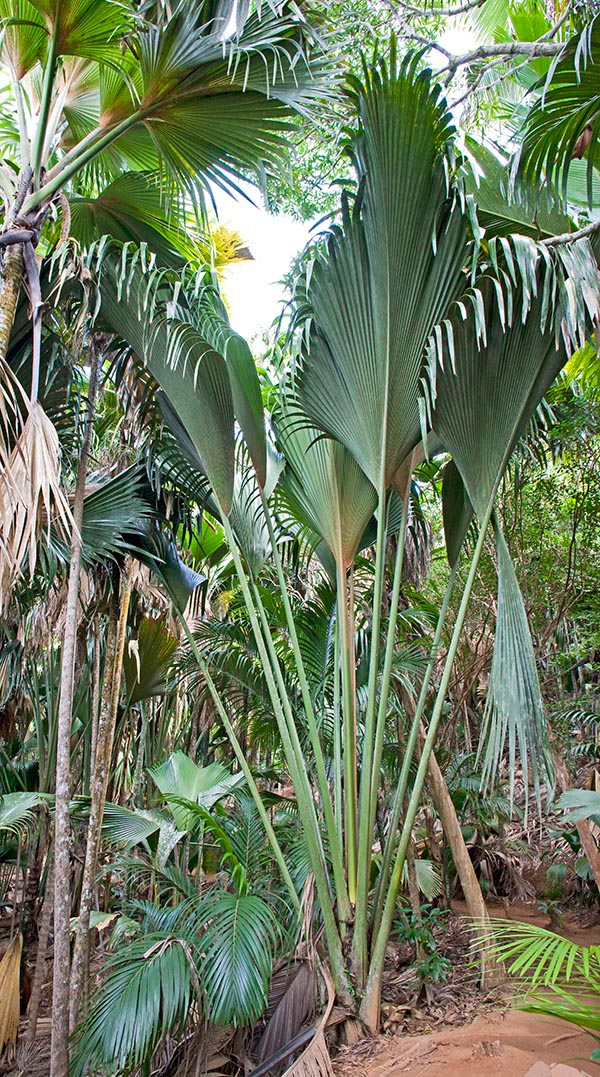
The young leaves of the Lodoicea maldivica reach almost the 14 m of length © Giuseppe Mazza
When prehistoric men were in difficulty, when they were feeling in danger in front of nature forces, their only resource was man.
To find a fellow man in the vicinity, might often mean salvation.
For this reason, even now, it happens to us, instinctively, to perceive a face in the clouds, or in the outline of a mountain.
In Middle Age, there was more time for reflection. They were more observers, and very attentive to the forms of nature, compared to man.
A “doctrine of omens” was even born.
The good God wanted to help man with signs: if the seed of a nut had the shape of a brain, that fruit was to treat head-ache; if the leaf of the lungwort, with its dots, was reminding a lung, doctors did prescribe it for lung diseases; and if the willow tree was growing with the roots in the water, its bark was a panacea for colds.
And with this mentality, when, at the beginning of sixteenth century, with the merchants, the first bilobated Seychelles nuts arrived in Europe, you can easily imagine the reactions.
It was perfectly reproducing, as per a chance, feminine anatomy. Pelvic region. The origin of life.
The “Coco fesse”, as it was immediately named, had surely magic powers, a remedy against all poisons, and aphrodisiac properties…. at least visual.
“Come and see my collection of “Coco fesse”, could say potent men to the beautiful courtesans, and consequently the price of these big seeds had no limits.
Nobody even knew where they were coming from.
Sailing vessels going to India were carrying them sporadically. And sailors were saying that they had found them adrift on the sea.
Whence, the name of “Coco de mer”, and the belief that they sprang up from a mysterious tree growing, like a seaweed, in the bottom of the ocean.
And seen that, floating or falling from a vessel of traders, a fruit had been between the waves of Maldives Islands, in 1750, Rumphius, the first botanist to study the plant, gave it the name of Cocus maldivica.
The real trees were discovered only later, in 1768, at Curieuse and Praslin, during the French exploration of Seychelles.
In 1801, the French botanist J.J. de La Billardière describes it accurately at the Academy of Sciences in Paris, and creates the name, more suited geographically, of Lodoicea seychellarum.
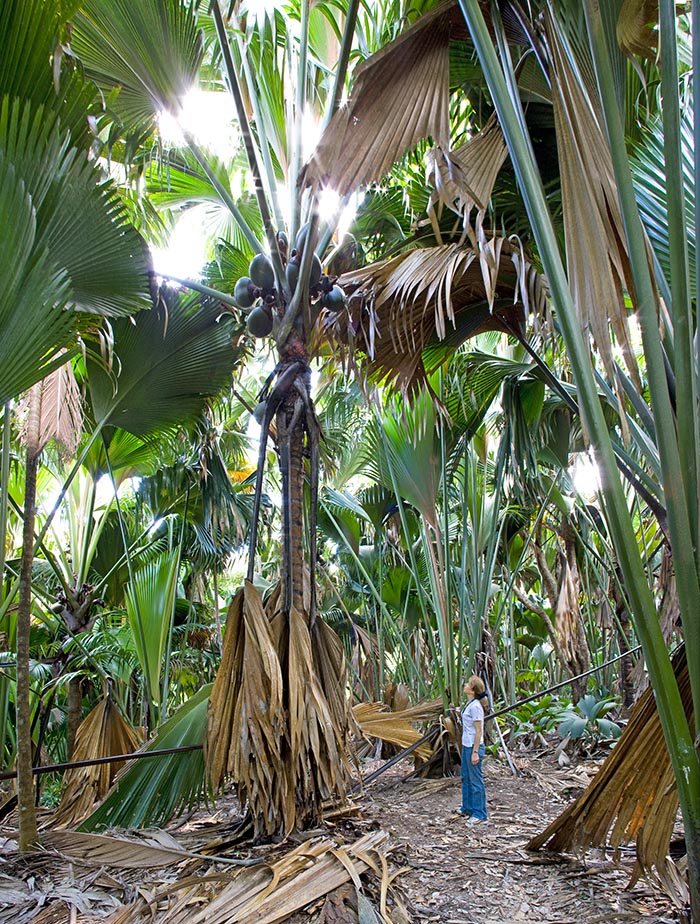
An adult Coco de mer, with fruits and young specimen on the sides, in the forest of the Vallée de May, Seychelles Islands © Giuseppe Mazza
But, it’s too late. In 1917, according to international conven- tions of scientific nomenclature, which give priority to older names, the plant is finally labelled as Lodicea maldivica.
Nowadays, apart the specimen of the adjacent island of Curieuse, of which I have laid down the history in the service about → Giant Turtles, the whole world population of this species is concentrated in the Vallée de Mai, an only 19.5 hectares area, in the island of Praslin.
An imposing forest, inhabited almost exclusively by palm trees, declared world patrimony by Unesco since 1983.
Mr. Lindsay Ching-seng, a local naturalist, who has written a book about them, leads us through the orderly foot paths.
“To walk here”, he explains to me, “is for a botanist like diving in the past, like meeting in person, nowadays, a settlement of dinosaurs.”
The granite rocks, polished by the time, which we see around us, are 650 millions of years old. They are among the most ancient of the planet, and date from the Pre-Cambrian, when these lands were united with Africa and India, forming the huge continent of Gondwana.
The wind tosses between them, with a metallic noise, some enormous leaves. They are all grooved towards the stem, in order to collect and convey the maximum amount of rainy water to the roots.
“Those belonging to young plants”, Lindsay goes on, “reach even 14 metres of length, but in adult plants, the size becomes more reasonable, as, otherwise, the tree would collapse”.
He shows me a sort of gigantic “strainer”, placed on the ground.
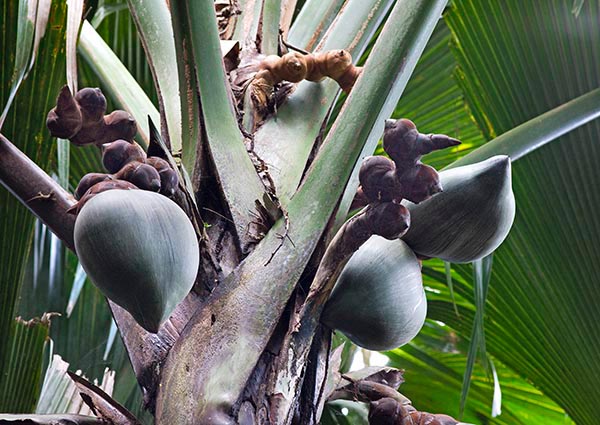
The typical large heart-shaped form of the fruit of the Coco de mer, when carrying one seed only © Giuseppe Mazza
It’s the basis of an old trunk. And innumerable fibres were passing through the holes, thus enabling the tree to wave, like on a joint, without any risk.
During the first 15 years of life, the Coco de mer do not have a stem. Then, this slowly grows up in 2-4 centuries. It can reach 24 metres in the females, and 30 in males. The Lodoicea maldivica is in fact a dioecious species, with the sexes separated in two plants.
In the Vallée de Mai, nowadays, there are about 7.000 feet growing up, with 200 adult males and 800 ladies. “The others”, Lindsay smiles, “are still too young to tell us what they are.”
Sexual maturity is in fact much variable.
Generally, we need 20-40 years to see the first fruit, but if the nourishment is scarce, as it happens in some parts of the forest, 50 years are not enough.
On the other hand, in the Botanic Garden of Victoria, a Coco de mer, well nourished, in full sun, when 11 years old, had already produced its first nuts, and often puts forth enormous ones, with “twin or triplets pregnancies”.
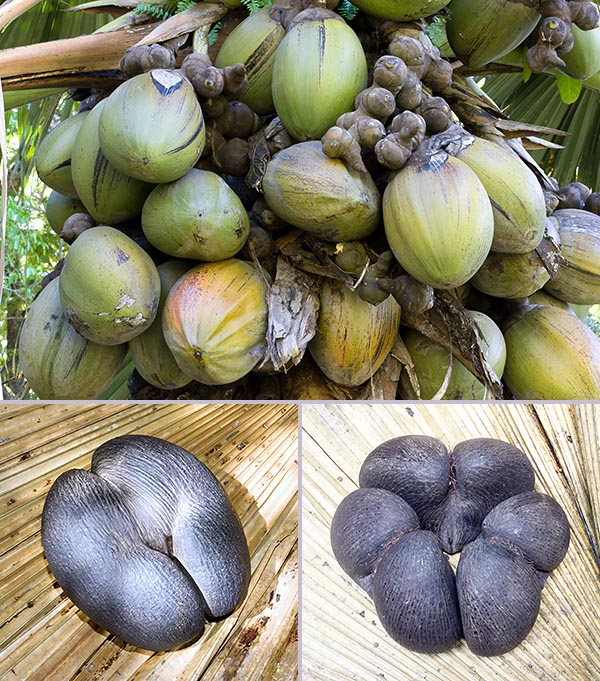
The fruit gets round when carrying several seeds. A single seed, and a triple one, after having been peeled © Giuseppe Mazza
The typical form of the fruits is the “heart”.
They take 6-7 years to ripen, and, generally, a plant carries a total of 30-45 of them, at various stages of ripening.
9 months or one year after fecundation, their size is almost the final one, and inside the seed, not yet formed, there is a translucent, edible, jelly.
Tasty dessert for multi-millionaires, or important visitors, seen that one single fruit costs more than 300 Euros.
Then, the jelly gets thick, and fills up the whole nut, becoming solid ivory.
And with its 20 kg, the seed of the Coco fesse is surely the biggest seed in nature.
“At the Vallée de Mai”, Lindsay continues, “they collect 12.000 nuts per year.”
But this is not sufficient to satisfy tourists requirements. 130.000 visitors, each season, wishing to take home this impressive seed.
Two nuts exactly the same do not exist. The curves, more or less stimulating, vary after the fruit, and if there is not sufficient room at home, one can opt for the twin or triplet forms, obviously smaller.
To render them transportable and avoid and unlawful reproduction out of the island, they are cut between the two lobes, emptied with patience, and skilfully stuck again.
In the shops you can really find versions for all tastes. The “natural” one for botanists, where, peeled, the nut is simply washed and cleaned with care; and the “elaborated” one, with the shell polished, or varnished, not to talk of the sexy additions of hair in the right position.
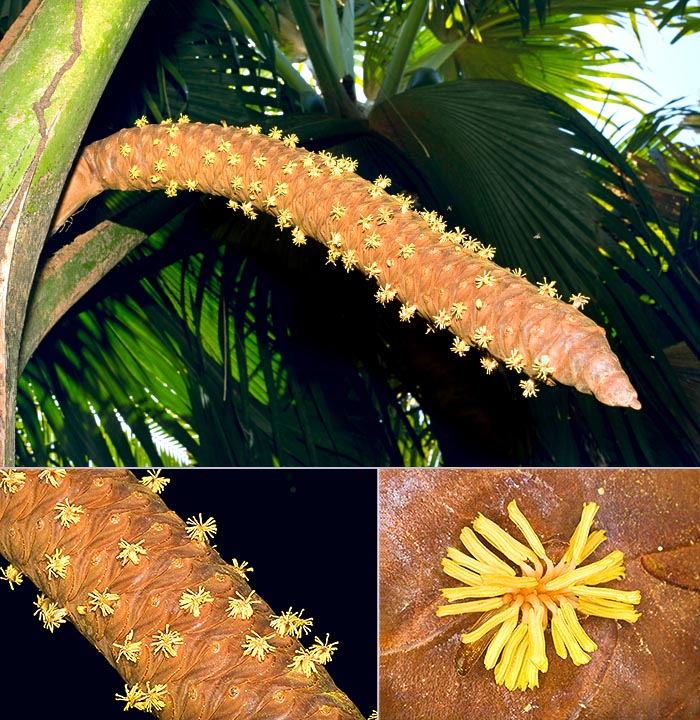
Inflorescence of the male plant, with small stellated flowers, rich of nectar, which can reach the two metres of length © Giuseppe Mazza
The stuffing, the vegetable ivory, is still now sent to India, where it is thought to hold aphrodisiac properties.
And artistic uses to not miss.
As it scales off easily on the horizontal bed, it’s very good for fabricating odd tesserae for playing dominoes.
The phallic inflorescence of the male plants is also surprising.
It appears inclined, then it rises, long even 2 metres, covered of small yellow flowers, rich of mawkish nectar and of pollen.
After about 6 months, and when aged, it becomes flabby again.
It is not astonishing, then, that in 1881, General Charles Gordon, visiting the Vallée de Mai, did elaborate, quite seriously, a fanciful theory after which the island of Praslin had been the birthplace of mankind, the famous Garden of Eden.
Our ancestors, Adam and Eve, had certainly lived here.
And with a fruit with the shape of a heart, that odd inflorescence and that seed, definitely forbidden, the Lodoicea maldivica was, without any doubt, the tree of Good and Evil.
Luckily, General Charles Gordon was not a botanist and did not have, like me, a 5 metres ladder handy.
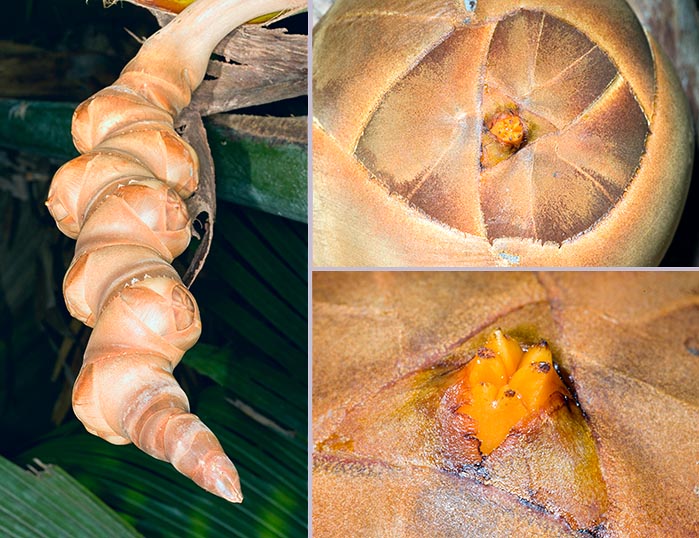
The feminine inflorescence shows several zigzagging spheres, in which centre, a fecund stigma comes out for a few hours only © Giuseppe Mazza
Otherwise, he should have been even more surprised.
While observing closer the young female inflorescences, one can discover that the zigzag buds resemble to “breasts with nipples”.
I cry aloud to Lindsay, and my wife Giusy, to hold the ladder well firmly, and I lean out, through the leaves, to look better at the structure.
Unlike male inflorescences, the female ones have, in the first place, very few flowers; In my case, for the moment, seven. They are accommodated in large cups, protected by very large, superposed bracts.
What I was looking for, the stigma, the feminine organ in the world of flowers, stays in the centre, dyed with a brisk red orange colour.
“You have been very lucky to see it”, Lindsay explains me, “because it gets out only for a few hours, just the time of the wedding”. Then, the following day, it withers.
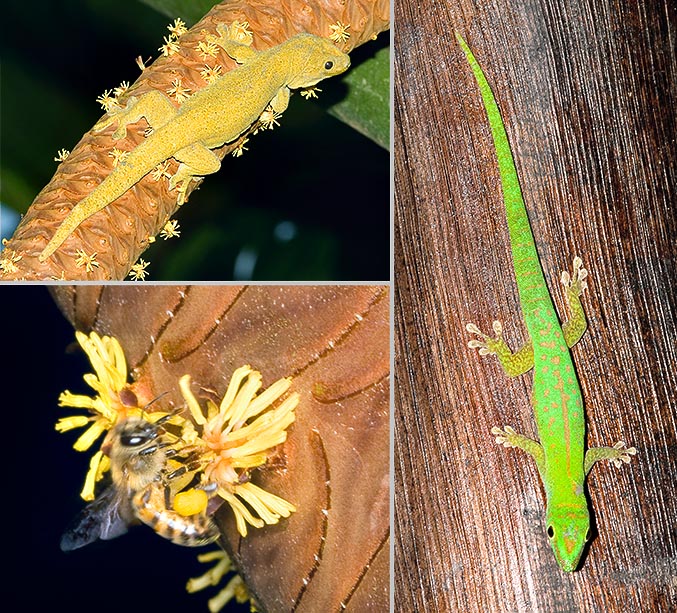
Pollination is entrusted also to the bees, the Green Geckos (Phelsuma), and the Bronze ones (Ailuronyx trachygaster) © Giuseppe Mazza
I mount all available range rings and I photograph, in double size from natural, on the captor, this rare “nipple”.
Like many stigmas, it is sticky and emanates the same sweetish scent as the male flowers.
“On a female inflorescence”, Lindsay continues, “generally a maximum of 3-5 are fecundated.”
And unlike other palms, pollinated by the wind, the Lodoicea maldivica employs a mixed strategy.
On one hand, the exaggerated production of pollen, and the fact that male plants are higher than female, make one think to an anemophilous pollination.
But, on the other, the showy look of the stigma and the little flowers, the copious nectar and the sweetish scent, show an evident interest for the animal world.
While I was shooting the photos, numerous dipterans and bees were buzzing around me. And we have seen also some reptiles.
By day-time, it’s easy to surprise the green geckoes (Phelsuma sp.), busy in licking the nectar which flows out at the basis of the anthers, or resting, where the sun filters, elated by the fragrance of the inflorescences.
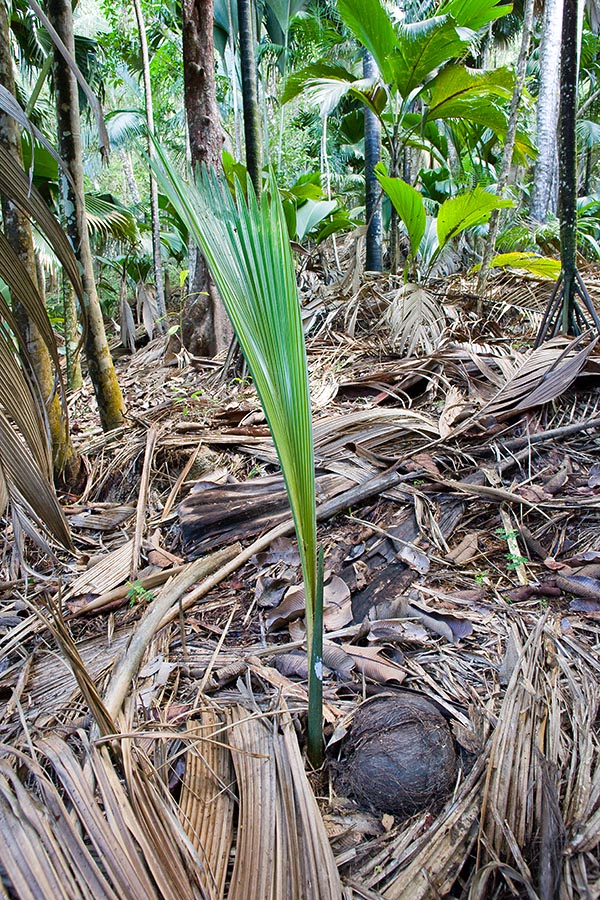
Germinating seed of Coco de mer, with the first leaf © Giuseppe Mazza
And, by night, the more massive bronzy Gecko (Ailuronyx trachygaster), provided of big paws which seem done purposely for pollination.
Then, we can ask ourselves what’s the use of the fruits so big and heavy, for carrying on the propagation of the species.
They are round, and when they fall down from 10-20 metres of height, they roll, as Lindsay says, even to several metres far away, especially if the ground is steep, as is the case of the forest of the Vallée de Mai.
But the fact that they accumulate kilos and kilos of reserves just to cross the ocean, and colonize, by swimming, other islands, is a real and simple invention.
If they fall into the sea, being so heavy, the fruits of the Lodoicea maldivica sink immediately, like stones.
Only few seeds, already partially decomposed, can, perhaps, float, but, by sure, will not go very much far away.
On the contrary, the plant gives evidence of a wise foresight in the germinative strategy.
The bark decomposes three, six months after the fall of the fruit.
From the opening between the two lobes of the seed, an odd sprout comes out, also this one rather phallic, with an enlarged tip, like a lance, which contains the bud.
It can slip into the subsoil immediately, as in the picture close by, or wind even for 10 metres, turning around the granite blocks, till it doesn’t find a fertile soil, and thick at least 60 cm.
And now it stops and roots, even very far away from the seed.
It will be necessary to wait one year, till the first leaf emerges from the soil, and two more, till the food reserves, patiently accumulated by mother Coco fesse into the seed, come to the end.
The umbilical cord disappears, and the forest has a new tree.
Besides the Lodoicea maldivica, the forest of the Vallée de Mai, keeps 6 more species of palms, likewise primitive and endemic of the Seychelles.
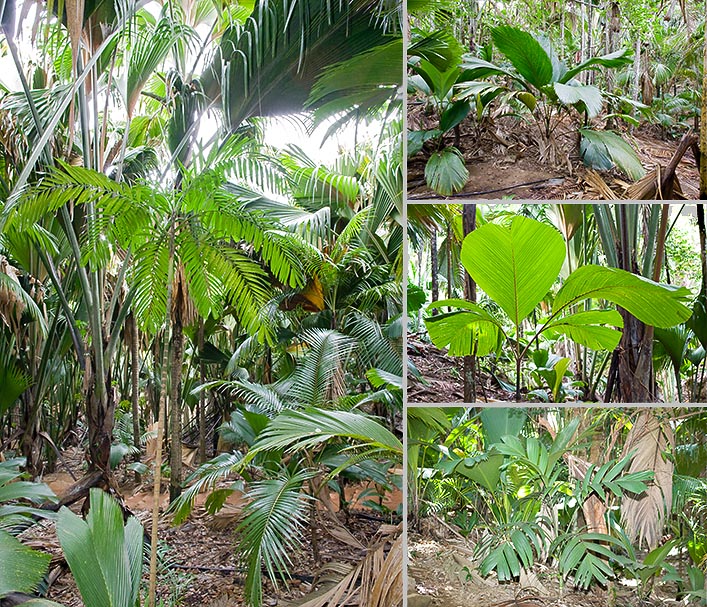
Nephrosperma vanhoutteanum, Phoenicophorium borsigianum, Verschaffeltia splendida and Roscheria melanochaetes © Giuseppe Mazza
The charming Nephrosperma vanhouttganum , which we saa in the photo on the left, close to a young Deckenia nobilis, holds the nice Creole name of Latannyen milpat.
Much smaller than the Coco de mer, it has the leaves subdivided in countless little “paws”, and bears small red fruits.
The young Phoenicophorium borsigianum, Latannyen fey, shown in the right upper side of the photograph, is the most common palm in the Seychelles. Its huge, solid leaves are traditionally used to cover roofs.
The Verschaffeltia splendida , the Creole Latannyen lat, grows up close to the streams, in the most humid areas of the park.
Once adult, it’s easily identified, for its spectacular external roots, united in a pyramid, as if they were supporting the trunk.
When young, leaves are much different, roundish, and create magic light games in the under brush.
But the pearl of the Vallée de Mai, is the Latannyen oban, the Roscheria melanochaetes.
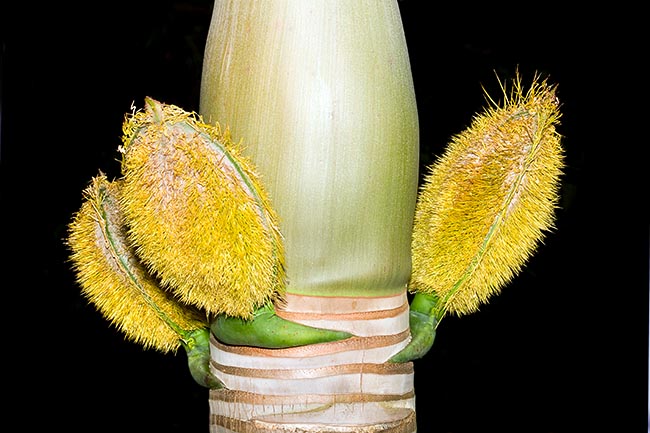
Deckenia nobilis: detail of the typical containers which protect the unripe inflorescences © Giuseppe Mazza
It has a very thin trunk and few leaves, deeply divided.
The forest has only two or three young specimen, which pass unnoticed, because of their small size, to the tourists’ hurried eyes.
The Palmis (Deckenia nobilis), on the contrary, is immediately remarked for its showy yellow curls, resembling to enormous pods, which fall, nobody knows where from, along the footpaths.
The tree, as a matter of fact, cannot be seen at the first instance, because often placed over the vault of the Coco fesse. A splendid 40 metres palm, with very elegant leaves, which wave in the wind.
Under their junction, placed like a crown around the trunk, are these big thorny cases.
They protect the young hanging inflorescences, and fall down once these ones do extend.
We do not know well what is their use. Maybe they are ad old defence against animals now extinct.
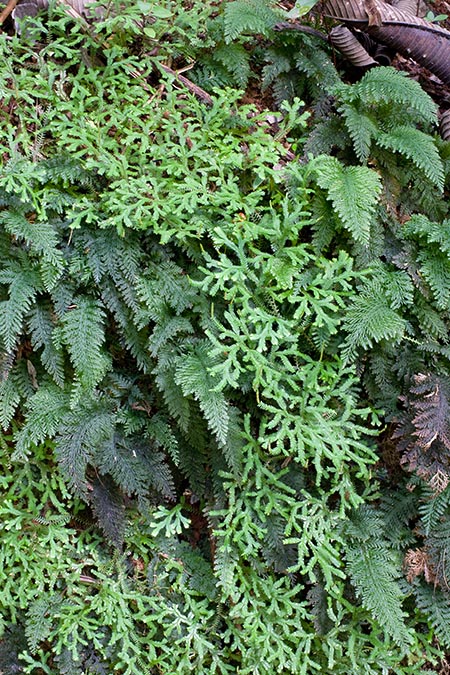
Selaginella fissidentoides and Trichomanes cupressoides in the under wood © Giuseppe Mazza
And, generally, apart the Lodoicea maldivica, we can notice that all these endemic plants, when young, have thorny leaves and stalks.
Probably to protect them from the voracity of Giant Turtles, which only few centuries ago, were the uncontested masters of the island.
Then, man has come. And also the poor Deckenia nobilis , in spite of the thorns, is meeting problems, because the bud is very tasty, and has already been nicknamed “Millionaires salad”.
The forest itself is in danger.
After having faced millennia, in its splendid solitude, around 1930, it was purchased by a private person, who wanted to build there a holiday residence, with exotic, decorative, fruit trees.
In 1948, it has been bought again by the Government, being necessary for the project of water collection at Praslin, and declared natural reserve in 1966. But the damage had been already done.
Nutmegs, vanillas, and philodendrons had invaded the spots, not to talk of many tropical plants, which had been introduced in order to create a sort of botanical garden.
Nowadays, the most has been removed. But many foreign species have by now scattered their seeds, and the struggle against epiphytes is very difficult.
Common philodendrons, which in our houses have difficulties in surviving, tied to their mossy tutors here grow up at sight, suffocating the trunks.
And if we tear them off, there is always a small fragment of root or a leaf, somewhere over there, between the branches, which soon will generate another plant.
Then, there is the danger of fires. If we think that almost the totality of Coco de mer is concentrated in this small strip of land, the risk for the species is extremely high.
In 1990, the fire has already swallowed a large part of the forest. And they cannot remove the dead leaves laying on the soil, as they protect the same from the excess of rain, hold the humidity, and create mould.
Around this green jewel, they have therefore created a deforested strip of land just to prevent fires to spread out, but, like the whole planet, here, every day, they live on a razor-edge.
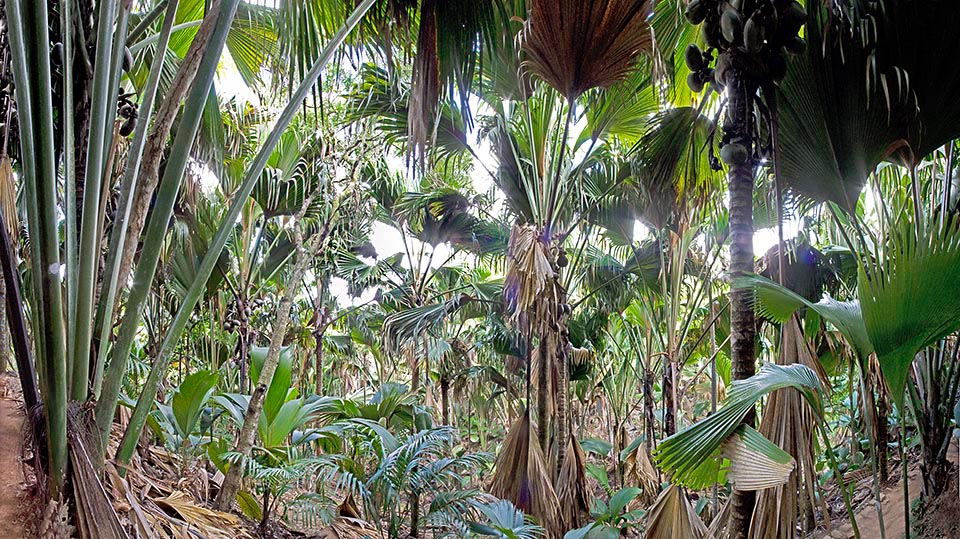
180 ° panorama of the Vallée de Mai © Giuseppe Mazza
– 2008 –
